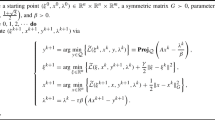Abstract
The revised simplex method is often the method of choice when solving large scale sparse linear programming problems, particularly when a family of closely-related problems is to be solved. Each iteration of the revised simplex method requires the solution of two linear systems and a matrix vector product. For a significant number of practical problems the result of one or more of these operations is usually sparse, a property we call hyper-sparsity. Analysis of the commonly-used techniques for implementing each step of the revised simplex method shows them to be inefficient when hyper-sparsity is present. Techniques to exploit hyper-sparsity are developed and their performance is compared with the standard techniques. For the subset of our test problems that exhibits hyper-sparsity, the average speedup in solution time is 5.2 when these techniques are used. For this problem set our implementation of the revised simplex method which exploits hyper-sparsity is shown to be competitive with the leading commercial solver and significantly faster than the leading public-domain solver.
Similar content being viewed by others
References
R.H. Bartels, “A stabilization of the simplex method.” Numer. Math., vol. 16, pp. 414–434, 1971.
J. Bisschop and A.J. Meeraus, “Matrix augmentation and partitioning in the updating of the basis inverse,” Mathematical Programming, vol. 13, pp. 241–254, 1977.
R.E. Bixby, “Solving real-world linear programs: A decade and more of progress,” Operations Research, vol. 50, no. 1, pp. 3–15, 2002.
R.E. Bixby, M. Fenelon, Z. Gu, E. Rothberg, and R. Wunderling, “MIP: Theory and practice closing the gap,” in System Modelling and Optimization: Methods, Theory and Applications, M.J.D. Powell and S. Scholtes (Eds.), Kluwer: The Netherlands, 2000, pp. 19–49.
W.J. Carolan, J.E. Hill, J.L. Kennington, S. Niemi, and S.J. Wichmann, “An empirical evaluation of the KORBX algorithms for military airlift applications,” Operations Research, vol. 38, no. 2, pp. 240–248, 1990.
V. Chvàtal, Linear Programming, Freeman, 1983.
G.B. Dantzig and W. Orchard-Hays, “The product form for the inverse in the simplex method,” Math. Comp., vol. 8, pp. 64–67, 1954.
J.J. Forrest and D. Goldfarb, “Steepset-edge simplex algorithms for linear programming,” Mathematical Programming, vol. 57, pp. 341–374, 1992.
J.J.H. Forrest and J.A. Tomlin, “Updated triangular factors of the basis to maintain sparsity in the product form simplex method,” Mathematical Programming, vol. 2, pp. 263–278, 1972.
D.M. Gay, “Electronic mail distribution of linear programming test problems,” Mathematical Programming Society COAL Newsletter, vol. 13, pp. 10–12, 1985.
J.R. Gilbert and T. Peierls, “Sparse partial pivoting in time proportional to arithmetic operations,” SIAM J. Sci. Stat. Comput., vol. 9, no. 5, pp. 862–874, 1988.
J.A.J. Hall and K.I.M. McKinnon, “LP test problems,” http://www.maths.ed.ac.uk/hall/PublicLP/, 2002.
P.M.J. Harris, “Pivot selection methods of the Devex LP code,” Mathematical Programming, vol. 5, pp. 1–28, 1973.
ILOG, CPLEX 6.5 Reference Manual, 1999.
R.D. McBride and J.W. Mamer, “Solving multicommodity flow problems with a primal embedded network simplex algorithm,” INFORMS Journal on Computing, vol. 9, no. 2, pp. 154–163, 1997.
R.D. McBride and J.W. Mamer, “A decomposition-based pricing procedure for large-scale linear programs: an application to the linear multicommodity flow problem,” INFORMS Journal on Computing, vol. 46, no. 5, pp. 693–709, 2000.
H.D. Mittelmann, “Benchmarks for optimization software,” http://www.plato.la.asu.edu/bench.html, April 2002.
J.A. Tomlin, “Pivoting for size and sparsity in linear programming inversion routines,” J. Inst. Maths. Applics, vol. 10, pp. 289–295, 1972.
R. Wunderling, “Paralleler und objektorientierter simplex,” Technical Report TR-96-09, Konrad-Zuse-Zentrum für Informationstechnik Berlin, 1996.
R. Wunderling, A. Bley, T. Pfender, and T. Koch, “SOPLEX 1.2.0,” 2002.
Author information
Authors and Affiliations
Rights and permissions
About this article
Cite this article
Hall, J.A.J., McKinnon, K.I.M. Hyper-Sparsity in the Revised Simplex Method and How to Exploit it. Comput Optim Applic 32, 259–283 (2005). https://doi.org/10.1007/s10589-005-4802-0
Received:
Revised:
Accepted:
Issue Date:
DOI: https://doi.org/10.1007/s10589-005-4802-0




